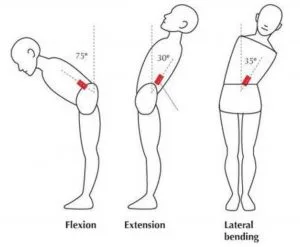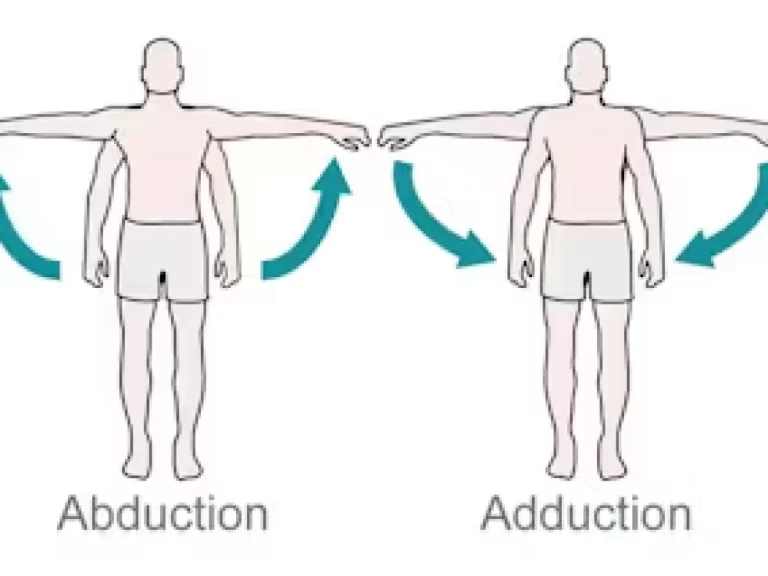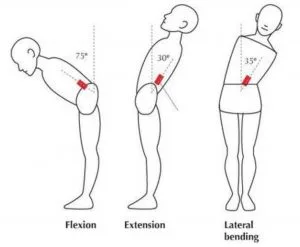Shoulder External Rotation
What is Shoulder External Rotation?
Shoulder external rotation is a movement of the arm or upper arm joint in which the humerus (humerus) rotates outward or laterally away from the midline of the body. This requires rotating the humerus at the shoulder, allowing the arm and forearm to move away from the center of the body.
The muscles responsible for external shoulder rotation contract, causing the arm to turn outwards.
External rotation of the shoulder is necessary for a range of tasks, including throwing a ball, reaching for things behind the back, and completing rotational motions in sports like baseball, tennis, and golf. Maintaining proper external rotator muscle strength and flexibility is essential for shoulder stability, balance, and injury prevention.
Maintaining appropriate external rotator muscle strength and flexibility is essential for shoulder stability, injury prevention, and general shoulder function. External rotation shoulder exercises, paired with a well-rounded program that incorporates both internal and external rotation exercises, can assist in maintaining shoulder health and enhance functional strength. It is worth noting that effective shoulder function requires a balance of internal and external rotation. An imbalance in these motions might result in shoulder dysfunction or injury. To strengthen the shoulders, add physical activity that targets both internal and external rotation.
Shoulder External Rotators Muscles
The shoulder’s external rotation is controlled by these muscles:
- Infraspinatus: The infraspinatus muscle lies behind the scapula. It is one of the shoulder’s primarily external rotators, contributing significantly to external rotational force generation.
- Teres minor: Teres minor is another muscle behind the shoulder blades, below the infraspinatus. It connects with the infraspinatus, which aids in external shoulder rotation.
- Rear deltoid: The anterior deltoid is one of the three ends of the deltoid muscle group, situated at the back of the shoulder. Although its major function is shoulder extension and horizontal abduction, it also helps with shoulder external rotation.
- In some circumstances, the deltoid’s posterior fibers and the triceps brachii’s long head can also help with the external rotation of the shoulder.
- These muscles work together to provide external shoulder rotation, which allows the arm to turn outward or laterally away from the body’s midline. To achieve optimal shoulder function and avoid imbalance or injury, the internal and external rotators must be balanced in terms of strength and flexibility.
ROM of Shoulder External Rotation
- Shoulder external rotation range varies from person to person and depends on factors such as flexibility, joint health, and past injuries. Degrees of rotation are commonly used to measure the range of motion.
- A healthy person’s usual range of external rotation for the shoulder is between 60 and 90 degrees. This signifies that the arm has some freedom to spin outward or laterally away from the body’s midline. However, it is necessary to note that the range of motion varies with age, gender, and individual characteristics. In some circumstances, tightness or muscular imbalances might impede the shoulder’s external rotation. Rotator cuffs and shoulder impingement are two examples of injuries that can limit motion.
- A health professional or physical therapist can test the range of motion of shoulder external rotation using goniometry, a gauge that measures joint angles. They will normally ask you to hold specific positions while rotating your arm outward and measuring the degree of rotation.
- If you are concerned about limitations in shoulder range of motion or external rotation, you should visit a clinician, such as a physical therapist. They can examine your specific condition and offer relevant advice, exercises, or activities to address restrictions or imbalances.
Benefits Of The Shoulder External Rotation Exercise
- Increased shoulder stability: External rotation exercises, which strengthen the rotator cuff muscles, can help prevent shoulder injuries like dislocations.
- Improving shoulder mobility.
- External rotation exercises can help develop shoulder range of motion and flexibility.
- Correcting improper posture: External rotation exercises can help to balance the strength of the internal and external shoulder muscles, hence correcting bad posture.
- Reducing the risk of injury: External rotators and stabilizers of the shoulder can be strengthened to help prevent rotator cuff tears and shoulder impingement.
- Improving overhead lifting: External rotation exercises might help you lift and reach overhead more efficiently.
Special Test For Shoulder External Rotation
If you want to do a particular shoulder external rotation test, utilize the “Hornblower test” or the “ER Lag Sign”. These tests measure the range of motion and integrity of the infraspinatus and smaller muscles that control the external rotation of the shoulder joint. Complete each test as follows.
Test of Hornblower:
Instruct the patient to sit or stand with one arm at their side, elbow bent at a 90-degree angle, and forearm pointing forward. Instruct the patient to externally rotate their shoulder, attempting to rotate the back of the arm away from their body. Examine the patient’s ability to fully externally rotate the shoulder joint and record any pain, weakness, or restriction of motion. Compare the results to the opposing shoulder.
ER Delay Signal (External Rotation Delay Signal):
Ask the patient to sit or stand with one arm at his or her side, elbow bent at a 90-degree angle, and forearm pointed forward. Instruct the patient to do as much external rotation of their shoulder as feasible. When they reach their external rotation range, instruct them to stay in that position. Support the patient’s arm in this posture and instruct them to remain still while you release the wrist or hand. Keep an eye on the patient for any delays or difficulties maintaining the externally rotated posture without your assistance. Compare the results to the opposing shoulder.
Both tests assess the function of the infraspinatus and teres minor muscles, which are important external rotators of the shoulder joint. A positive test result (pain, weakness, or difficulty in sustaining external rotation) could indicate an injury or disease in these muscles.
Shoulder External Rotation Stretching
External Rotation in the Corner or Doorway
Face a corner or a doorway and position your arms at shoulder level. Lean slightly forward toward the corner until you feel a stretch.
Standing Neutral External Rotation
Hold a door handle or frame with the affected arm. Rotate your body away from the door while maintaining the injured arm firmly against your side and the elbow at 90 degrees. This will result in outward rotation of the shoulder.
Exercise For Shoulder External Rotation
Here’s an exercise to assist in increasing your shoulder external rotation:
Wand Shoulder External Rotation Exercise
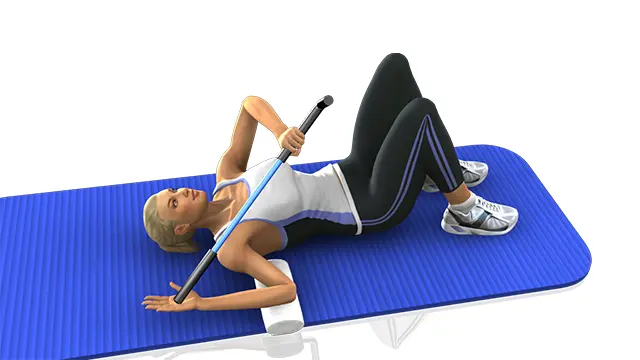
Lie on your back with a cane or wand in each hand. Place a small rolled towel or cushion under the injured elbow. Maintain an approximate 90-degree bend at the elbow. Your arm should be about 30-45 degrees away from your side. Using your other arm, drag the wand/cane to spin the person’s affected side. Pull your arm back into a stretch. Hold and then return to the beginning position. And then repeat. Repeat 5 times. Hold 15 seconds. Complete one set, and perform it once a day.
Strengthening Shoulder External Rotation Exercise
Dumbbell shoulder external rotation
Lay on your back and raise your elbow straight out from your shoulder on the ground. Hold the dumbbell straight up to create a 90-degree bend at the elbow. Slowly rotate the shoulder back and forth while maintaining the 90-degree bend in the elbow. You should feel the rotator cuff muscles working hardest in your shoulder. Do not allow your elbow to straighten away from your body or bring it too near to it. Maintain a pure rotation around the shoulder.
Shoulder External Rotation With Theraband
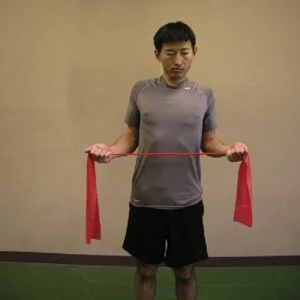
Connect a resistance band to a stationary object at waist height. Stand with your knees slightly bent and facing the anchor point to the side. Hold the resistance band with one hand on the affected shoulder while keeping the elbow at a 90-degree angle and the forearm parallel to the ground. Throughout the exercise session, keep your elbows and upper arms still. Begin with your forearm facing your stomach. Holding the strap, gradually move your forearm outside and away from your body. Pause briefly at the end of the range of motion, then gently return to the starting position. Work both sides for 2-3 sets of 10-15 repetitions. This exercise works the shoulder’s external rotator muscles, notably the infraspinatus and teres minor. As your strength grows, progressively increase the band’s resistance. Begin with light resistance and pay attention to how your body responds.
Shoulder External Rotation With Cable
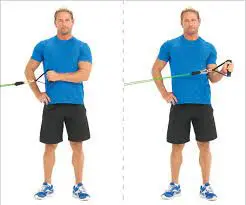
Set the cable pulley at elbow height. Stand with your feet slightly wider than shoulder-width apart and the cable machine on your right. Hold the handle in a neutral grip with your left hand. Bend your left elbow 90 degrees and keep it tucked into your hip. Inhale, then exhale while turning your shoulder outward, drawing the rope away from the pulley. Exhale again and slowly twist your shoulder inward to return to the beginning position. Repeat for the opposite side.
Manual Muscle Testing: Shoulder External Rotation
Grading
Grade 5 (normal): Push to the maximum of the range and provide as much resistance as achievable.
Grade 4 (good): A whole range is possible, but it demands a high level of resistance.
Grade 3 (fair): There is no physical resistance during the entire range of action.
Grade 2 (Poor): A whole partial range of motion is provided.
Grade 1 (Trace): A noticeable flicker of contraction induced by osteokinematic activity, muscle contraction, or tendon contraction.
Grade 0: No tendon, muscle, or osteokinematic activity is seen.
Grades 3 to 5
Patient Position
Prone position, head turned to the test side, shoulder abducted to 90°, and a folded towel put under the distal arm with the forearm dangling vertically from the edge of the bed.
Therapist Position
Stand on the test side. For resistance, position one hand on the dorsal side of the forearm, just above the wrist, while the other hand applies counterforce at the elbow.
Instructions to the Patient
Hold your forearm and move it up and back. Rotate your arm till your palm is closer to the table. Do not allow me to pull it up.
Grade 3 (Fair): There is no physical resistance during the entire range of action.
Grade 4 (good): Complete the available range of motion while maintaining moderate to minimal resistance.
Grade 5 (normal): Complete the available range of motion and maintain maximum resistance.
Grades 2 and 1
Patient Position
The prone position with the head turned to the test side and the patient at the edge of the bed, allowing the full arm to hang freely. The arm is held neutrally (palm facing the table).
Therapist Position
On the test side, stand or sit down at a low table. The therapist should keep the test arm stable at the shoulder.
Instructions to the Patient
Move your forearm up and back. Rotate your arm till your palm is closer to the table. Do not allow me to pull it up.
Grade 2 (Poor): Instruct the patient to rotate their shoulder externally in the designated position.
Grade 1 (Trace): A noticeable flicker of contraction induced by osteokinematic activity, muscle contraction, or tendon contraction.
Grade 0: No tendon, muscle, or osteokinematic activity is seen.
FAQs
What are the benefits of shoulder external rotation exercise?
Maintain proper shoulder health. Make your posture better. Improve the strength of your infraspinatus muscle. Improve overhead lifting and reaching.
What are the three muscles that externally rotate the shoulder?
The deltoid is located in the posterior, Infraspinatus, And Ters Minor.
What nerve is external rotation?
axillary nerve
What is the benefit of isometric shoulder external rotation?
Strengthens the rotator cuff, resulting in increased shoulder joint stability.
What are the benefits of shoulder rotation exercises?
Rotating your shoulders in a circular motion, both forward and backward, will help you improve mobility, flexibility, and strength while also boosting upper body health.
What causes shoulder pain with external rotation?
Internal impingement causes posterior shoulder pain when an athlete positions the humerus in excessive external rotation and abduction, such as during the cocking phase of pitching or throwing.


